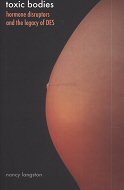|
Toxic Bodies: Hormone disruptors and the legacy of DES
|
|
Nancy Langston
|

|

In 1941 the Food and Drug Administration approved the use of diethylstilbestrol (DES), the first synthetic chemical to be marketed as an estrogen and one of the first to be identified as a hormone disruptor - a chemical that mimics hormones. Although researchers knew that DES caused cancer and disrupted sexual development in laboratory animals, doctors prescribed it for millions of women, initially for menopause and then for miscarriage, while farmers gave cattle the hormone to promote rapid weight gain. Even after evidence emerged that DES did not ban its use in beef until forced by the public pressure. Its residues , and those of other chemicals, in the American food supply are changing the internal ecosystems of human, livestock, and wildlife bodies in increasingly troubling ways.
In this gripping exploration, Nancy Langston shows how these chemicals have penetrated into every aspect of our bodies and ecosystems, yet the U.S. government has largely failed to regulate them while the industry has skillfully manipulated scientific uncertainty to delay regulation. Personally affected by endocrine disruptors, Langston argues that the FDA needs to institute proper regulation of these commonly produced synthetic chemicals.
Nancy Langston is a professor in the Department of Forest and Wildlife Ecology with a joint appointment at the Nelson Institute for Environmental Studies at the University of Wisconsin, Madison. She is the author of Where Land and Water Meet: A Western Landscape Transformed and Forest Dreams, Forest nightmares: The paradox of Old Growth in the Inland West
|
|
